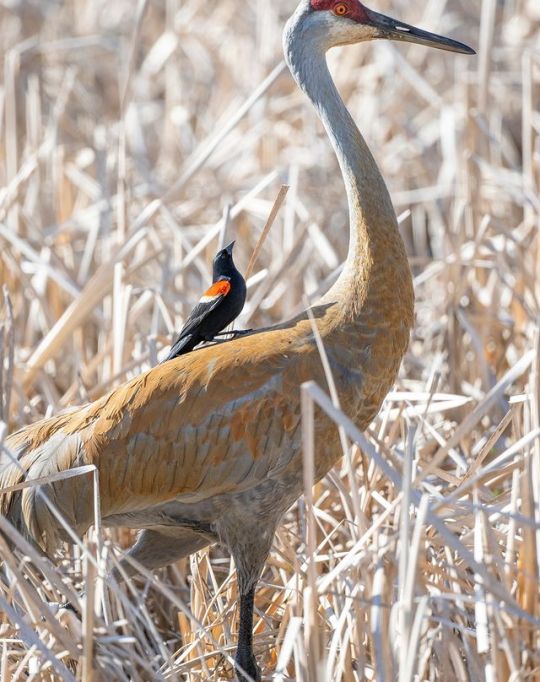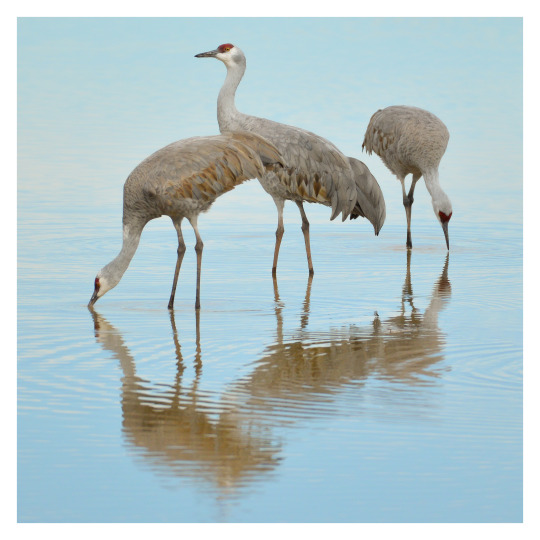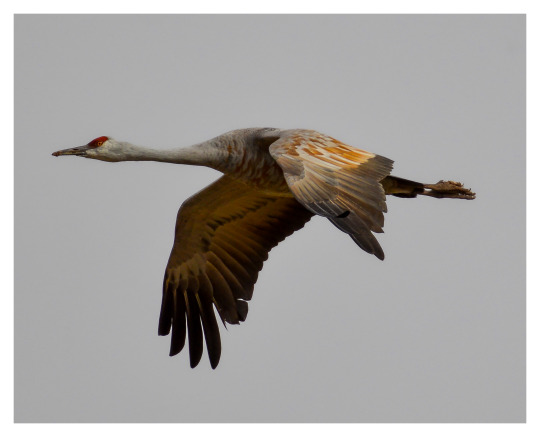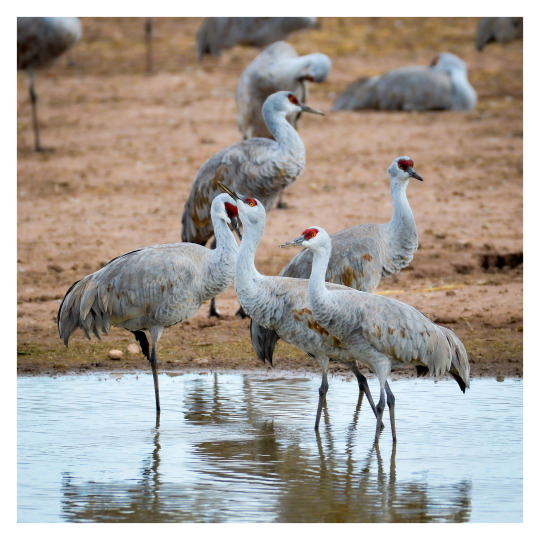#sandhill crane Antigone canadensis
Explore tagged Tumblr posts
Text

Sandhill Crane & Red-winged Blackbird
#sandhill crane#crane#Antigone canadensis#Gruiformes#Gruidae#Antigone#red winged blackbird#blackbird#Agelaius phoeniceus#Passeriformes#Icteridae#Agelaius#bird#upl
3K notes
·
View notes
Text





A day with the cranes.
Sandhill cranes / grulla gris (Antigone canadensis) at Whitewater Draw, Cochise County, Arizona.
The Arizona Game and Fish Department estimates that the overwintering population in the county is about 42,000 cranes this year, with most of the birds occupying Willcox Playa, and only about 13,000 at the draw.
#photographers on tumblr#sandhill cranes#Antigone canadensis#Whitewater Draw#Arizona Game and Fish Department#Cochise County#Arizona
1K notes
·
View notes
Text
Highway to new horizons. 🛣️🕊️



#Power Lines#Power Towers#Cloudy Sky#Birds Flying#Sandhill Crane#Antigone Canadensis#Cranes#Bird#Plants#Sky#Clouds#Mountains#Desert#Travel#Interstate#Highway#Nevada#Arizona
118 notes
·
View notes
Text


Photo source
Map source
#poll#birds#sandhill crane#gruiformes#gruidae#antigone#antigone canadensis#america#north america#eurasia#asia
71 notes
·
View notes
Text

A pair of sandhill cranes (Antigone canadensis) in North America
by Tina Vance
#sandhill crane#cranes#aves#antigone canadensis#antigone#gruidae#gruiformes#chordata#wildlife: north america
121 notes
·
View notes
Text
BOTD: Sandhill Crane

Photo: Wendy Miller
"Found in several scattered areas of North America, Sandhill Cranes reach their peak abundance at migratory stopover points on the Great Plains. The early spring gathering of Sandhills on the Platte River in Nebraska is among the greatest wildlife spectacles on the continent, with over a quarter of a million birds present at one time. Although they are currently very common, their dependence on key stopover sites makes them vulnerable to loss of habitat in the future."
- Audubon Field Guide
#birds#sandhill crane#birds of north america#north american birds#cranes#birds of the us#birds of canada#birds of mexico#birds of the caribbean#waders#wading birds#birding#bird watching#birdblr#birblr#bird of the day#Antigone canadensis
73 notes
·
View notes
Text

Migratory May day 21: Sandhill Crane
Reference photo by Bill Koley
#migratory may#sandhill crane#crane#cranes#antigone canadensis#antigone#gruidae#gruiformes#bird#birds#bird art#ornithology#art#digital art#artists on tumblr#tw eyestrain#cw eyestrain#wauk wauk
35 notes
·
View notes
Video
Sandhill Parents by kevin moore Via Flickr: A small colt was nearby but not visible.
0 notes
Text

Sandhill Cranes (Antigone canadensis), THEY SREMMM!!!, family Gruidae, order Gruiformes, Fairbanks, Alaska
photograph by Lotze Art & Design
2K notes
·
View notes
Text

Sandhill Crane Antigone canadensis
3/30/2022 Orange County, Florida
#bird#birds#bird photography#sunset#sunset photography#aesthetic#nature aesthetic#nature#wildlife#florida#florida wildlife#my photos
186 notes
·
View notes
Text

The Sandhill Crane. . .
The sandhill crane (Antigone canadensis) is a large crane species found in North America and extreme northeastern Siberia. Sandhill cranes frequent the edges of bodies of water, including marshes. Sandhill cranes are incredibly social birds. When migrating, they form flocks that can be as large as tens of thousands. Their distinctive rolling cries fill the air during these impressive gatherings.
During migration, they travel to areas in New Mexico, Texas, and other parts of North America. The central Platte River valley in Nebraska serves as a crucial stopover area for the great sandhill crane, with up to 450,000 birds passing through annually.
-----------
Image credit: Shane Kalyn
Text credit: Earth of Wonders
72 notes
·
View notes
Photo

Sandhill Crane
313 notes
·
View notes
Text
A day with the cranes




The Whitewater Draw sandhill cranes leave the draw at dawn each morning to glean grain from the stubble of nearby cornfields in the Sulphur Springs Valley. The Swisshelm mountains provide a backdrop for their feast in these photos.


After hours of feeding the flocks return to the draw with crops full of corn. During mid-day they linger in the draw's shallow water for loafing hours – letting the corn in their gullets soften for digestion. The draw provides some protection from predators during this period of relative inactivity.

Even when they assemble on land or fly in vast numbers, the birds keep together in family groups comprised of parents and one or (occasionally) two first-year youngsters. The parents teach the young birds their migratory route, and will remain with them until the northern migration begins in the spring. In this photo the juveniles flying close to mom and dad are just beginning to display their bright red forehead feathers.



Loafing time at the draw is not quiet time. There is constant crane chatter and squawking. Little tiffs erupt, as birds jostle with neighbors. There are no official counts yet available, but this year's flock will likely be equal to last year's, with about 12,000 birds at Whitewater Draw, and up to 30,000 more on the Willcox Playa.
Sandhill cranes / grulla gris (Antigone canadensis) at Whitewater Draw, Cochise County, Arizona.
#photographers on tumblr#sandhill cranes#Antigone canadensis#Whitewater Draw#Arizona Game and Fish Department#Cochise County#Arizona
63 notes
·
View notes
Text

- 2021 Audubon Photography Awards: Sandhill Crane (Antigone canadensis) with Colt in Florida, USA.
- Photo Courtesh of Robin Ulery.
26 notes
·
View notes
Text


Sandhill Cranes at Sawtooth Range, Idaho, USA
Tim Peterson
Conservation Status: As a species, they are not considered threatened. Mass: 7.1 – 11 lbs Scientific name: Grus canadensis Nickname: rib eye of the sky Class: Aves Domain: Eukaryota Family: Gruidae Genus: Antigone Habitat: Small bogs, marshes, prairies Flight Speed: 25-35 mph Flight Distance: 200-300 miles a day, but can reach 500 miles with a good tail wind. Range: Northern North America, Southeastern US, extreme Northeastern Siberia Diet: Omnivorous. Seeds, berries, roots, corn, wheat grains, rodents, snails, insects, frogs, lizards, and nestling birds.
Why are they important?
A 10 million year old sandhill crane fossil was found in Nebraska. This discovery makes them the oldest known surviving bird species. These living fossils still follow their ancient migratory routes from breeding grounds in the northern prairie marshes to southern wintering areas each fall.
They are considered one of the most successful life forms on Earth, having outlasted more than 99% of all species that ever existed.
Fun Facts:
Sandhill cranes mate for life and stay with their mates year-round
Chicks can leave the nest within 8 hours of hatching, and are even capable of swimming.
Sandhill cranes are territorial during the breeding seasons, and each pair will vigorously defend its nesting area.
Sandhill cranes "paint" themselves by preening mud into their feathers prior to the breeding season. Sandhill cranes preen because:
Helps them hide amid the brown vegetation in a marsh
Waterproofs feathers
Insulates feathers
Increased aerodynamics
Attracting a mate
Keeping a mate
#Sawtooth Range#Idaho#USA#Sandhill Crane#Sandhill Cranes#Bird#Birds#Wildlife#IDWildlife#US#United States#North America#United States of America#Crane#Cranes
30 notes
·
View notes
Photo

Sandhill Crane (Antigone canadensis)
5/12/23
135 notes
·
View notes
